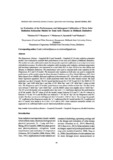Please use this identifier to cite or link to this item:
https://cris.library.msu.ac.zw//handle/11408/1822| Title: | An evaluation of the performances and subsequent calibration of three solar radiation estimation models for semi arid climates in Midlands Zimbabwe | Authors: | Zirebwa, F.S. Kapenzi, A, Makuvaro, V. Sammie, B. Madanzi, Tendai |
Keywords: | Solar radiation, Bristow – Campbell, Donatelli – Campbell, Hargreaves, Model Evaluation | Issue Date: | 2015 | Publisher: | Midlands State University | Series/Report no.: | Midlands State University Journal of Science, Agriculture and Technology;Special edition; p. 44-55 | Abstract: | The Hargreaves, Bristow – Campbell (BC) and Donatelli – Campbell (CD) solar radiation estimation models were evaluated to establish their performances in the semi arid climate of Midlands Zimbabwe. The models were also calibrated to attain the site specific empirical coefficients so as to improve in terms of prediction accuracy. To achieve this evaluation, daily incoming solar radiation, minimum temperature and maximum temperature were measured for a year (July 2013 to June 2014) at two sites (Mlezu and Mvuma) in Midlands Zimbabwe. The temperatures were used to calculate daily solar radiation for the Hargreaves, BC and CD models. The measured solar radiation at both sites was used to evaluate the performances of the models using the Mean Absolute Prediction error (Err), Model Efficiency (EF), Root Mean Square Error (RMSE), Bias and coefficient of determination (R2). All models were calibrated using linear regression equations. The BC model performed better than the other models overall. The least performer was the CD model. The BC model had the lowest Err (17.85 % and 16.31 %), RMSE (3.725 MJm2day1 and 3.486 MJm2day1) and Bias (2.501 MJm2day1 and 1.281 MJm2day1) values at both sites. The Hargreaves and CD models’ performances were almost similar at both sites. The Bias levels were between 3 MJm2day1 and 4 MJm2day1, and the RMSE values were slightly above 4 MJm2day1. The EFs of all the models were acceptable since they were > 0. Calibration improved the performances of all the models. The EF values of all the models ranged between 0.55 and 0.7, the Err reduced to between 11 % and 16 % and the Bias was reduced to < 0.5 MJ m2 day1 for the Hargreaves and BC models. The Bias was however still higher for the CD model (~ 2 MJ m2 day1). The average site specific “K” coefficient of the Hargreaves model, the “a” coefficient of the BC model and the CD_b coefficient of the CD model were found to be 0.1361, 6.274 and 0.1895. Solar radiation estimation models are supposed to be calibrated before use for improved prediction accuracy. | URI: | http://hdl.handle.net/11408/1822 |
| Appears in Collections: | Research Papers |
Files in This Item:
| File | Description | Size | Format | |
|---|---|---|---|---|
| agronomy.pdf | Full Text | 5.56 MB | Adobe PDF |  View/Open |
Page view(s)
12
checked on Jul 25, 2024
Download(s)
2
checked on Jul 25, 2024
Google ScholarTM
Check
Items in MSUIR are protected by copyright, with all rights reserved, unless otherwise indicated.



